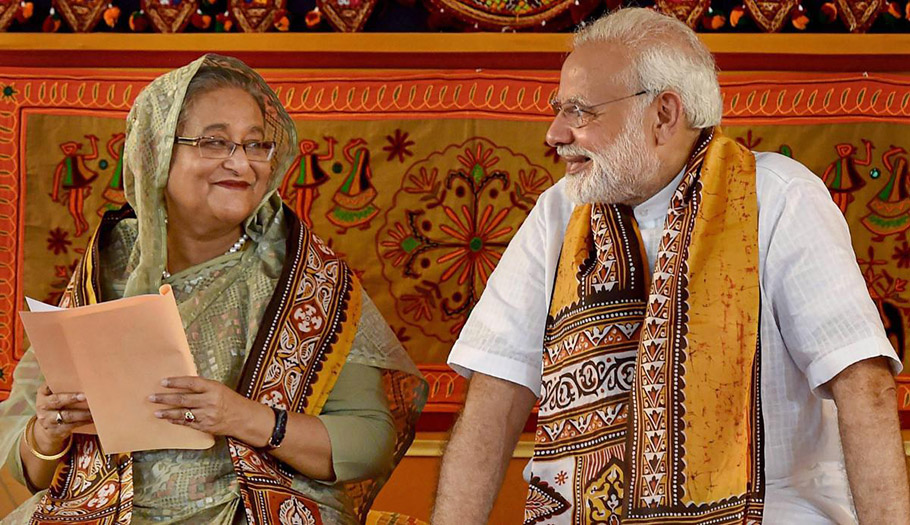
India should keep Bangladesh close for fruition of Act East vision

The violent protests orchestrated by Hifazat-e-Islam against Prime Minister Narendra Modi’s Bangladesh visit that led to a dozen deaths in police firings, have driven home the rising surge of radical Islamist challenge faced by the Sheikh Hasina-led Awami League government. Modi’s visit was just an excuse to intensify the agitation for regime change because the Hifazat has continuously raked up violent public protests since the Awami League returned to power two years ago.
First it was against the installation of statues of the country’s founder Sheikh Mujibur Rehman on his birth centenary. Then the Hifazat encircled the French embassy and burnt President Emmanuel Macron’s effigies over his comments on Islam following the beheading of a schoolteacher who had shown caricatures of Prophet Mohammad to his students.
The street protests raged alongside a furious social media campaign against Indian vaccines by anti-India and anti-Awami League elements. This included a few western lobbyists, Bangladeshi civil society elements and activists from the country’s Islamist eco-system (that range from the opposition and rabidly pro-Pakistan BNP and Jamaat-e-Islami to Islamic radical groups like Hifazat-e-Islam and Khilafat-e-Majlis to underground jihadi terror groups like JMB and Ansarullah Bangla).
Related news: India-Bangladesh relations to get more intense and rewarding
One line questioned the quality of India-made vaccines or ‘gomutra vaccine’ as some posted, while the other raised doubts if India will abide by its committed supply of vaccine doses to Bangladesh. When all that fell through after Pune-made vaccines landed in Dhaka and the Hasina government kick-started an ambitious vaccination programme entirely dependent on India-made jabs, the detractors spread rumours of adverse effects of the vaccine in India itself. Finally, it was left to Hifazat to launch massive protests when Modi landed in Dhaka as the guest of honour on the Golden Jubilee of Bangladesh’s independence.
The Awami League and the government has hit back since then. The detention of a top Hifazat leader Mamunul Haque with a massage parlour girl from a resort in Narayanganj gave pro-government elements the chance to hit back on the social mediascape. Ayesha Zaman Shimu, a top leader of the Awami league has even challenged the Hifazat and the Islamist clergy to come clean on widespread allegations of child abuse in madrassas (seminaries) controlled by them , while posting pictures of a maulana allegedly engaged in sex with a minor boy. The government has now called for bank account details of 54 Hifazat leaders to check on allegations of Pakistani funding for the radicals, amidst some evidence of ISI funding for the anti-Modi protests.
What helps the Islamist radical cause in Bangladesh and weakens the raison d’etre for secular politics, is the rise of Hindutva politics in India and the fever-pitch anti-Bangladesh tirade by even senior BJP politicians. While Modi talks of Mujibur Rahman as a ‘game-changer’ for South Asian politics when in Dhaka, his Home Minister Amit Shah berates Bangladeshi migrants as ‘termites.’ The anti-infiltration tirade by the BJP in the West Bengal and Assam elections and the drum-beating of ‘Muslim appeasement’ trigger an anti-Indian surge which the Islamist radicals take advantage of and which embarrasses India’s friends in the Awami League and other secular groups. Bangladeshis say illegal migration to India is a thing of the past, when the country was described as a ‘basket case’ by Kissinger. Now, half-a-million Indians work in Bangladesh and Bangladeshis make up for 23 per cent of India’s tourist arrivals, spending much more money in the country than cannabis-puffing Westerners.
Modi-Shah and Hindutva preachers need to come to terms with Bangladesh’s phenomenal economic growth which provides a huge development opportunity for India’s East and Northeast. India’s ‘Act East’ will not work unless Bangladesh plays ball as it continues to grow. Mamata Banerjee missed out on that opportunity of leveraging Bangladesh’s economic growth for some in her own state by playing domestic politics over the proposed Teesta water-sharing agreement. On the other hand, West Bengal became the extended sanctuary of Bangladesh’s Islamic radicals when they fled Hasina’s furious crackdown. Hasina kept pitching for determined Indian action against the Islamic radicals like she had done against them and against Northeastern ethnic insurgents.
Related news: In Bangladesh, PM Modi talks of trade, commerce and terrorism
The BJP which rules the country and is keen to rule Bengal must come to terms with the hollowness of its anti-infiltration rhetoric and pitch for tough anti-radical action and mutual development that the World Bank predicted in its recent report on connectivity. It said the national income of India and Bangladesh will grow by 8 to 10 per cent with greater connectivity and exports would grow by 200 to 300 per cent. Indira Gandhi, often seen as the liberator of Bangladesh, knew India’s Eastern Question could be effectively tackled only if we had a friendly Bengali nation on our eastern flank. The sooner the saffron realise this, the better for India.
(The writer, a veteran BBC and Reuters correspondent, worked as a senior editor in Dhaka-based bdnews24.com between 2013-2016)

